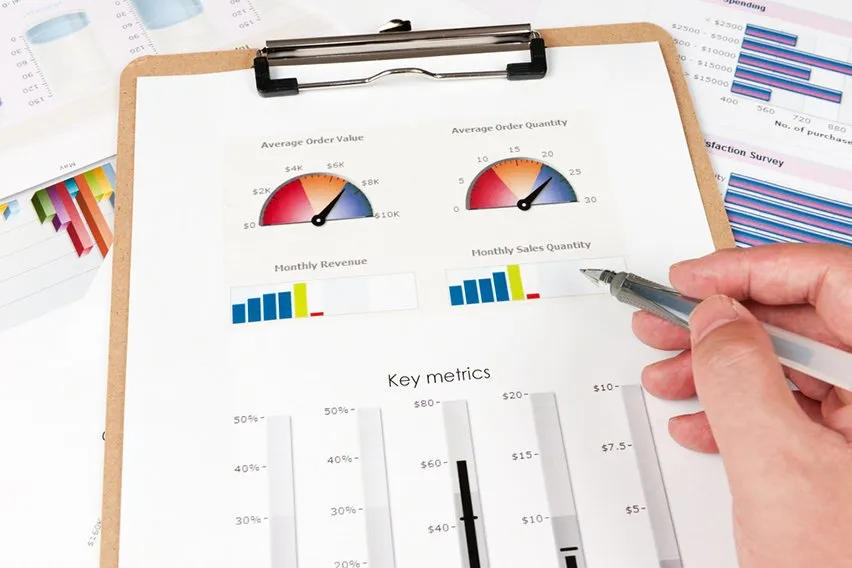What Are Performance Metrics? Definition & Examples

Tracking progress is important in every aspect of life. It’s especially important in business. The problem that you’ll encounter when tracking progress in a business is the sheer volume of things to track! Thankfully, there are a handful of tracking measurements available to business owners. These are known as performance metrics, and they can give you insight on every aspect of your company. If you’re looking for ways to assess the success or progress of your company, look no further! We’re reviewing performance metrics in depth! Keep reading to find out more.
Here’s What We’ll Cover:
4 Categories to Track with Examples
What Are Performance Metrics?
Performance metrics are measurable data that can track a number of things within a business. They’re commonly used to track business activities, employee behaviour, and productivity. They measure the overall achievement of business goals. Using collected data, business owners can measure and evaluate progress against expected results.

Are They the Same as Key Performance Indicators?
No, they aren’t. A performance metric is measured against an established goal. They are broader in scope than a key performance indicator is. Key performance indicators (KPI) are used to measure very specific targets. For example, a performance metric will measure the progress of an entire department working towards a goal. A KPI will review a specific task that the department carried out in relation to the broader goal.
Why is Using a Performance Metric Important?
Generally speaking, using performance metrics to measure progress can drive business decisions. By using these metrics, you can observe what is promoting growth, as well as what is hindering it. When you identify shortcomings, you can implement training activities to strengthen those areas. You can also start to track trends in departments or employees. When you recognize issues, they can be resolved.
Identifying performance characteristics is an excellent way to improve your business. Trending data provided by metrics can bring performance characteristics into view. They may be departmental or individual. Regardless, understanding the overall performance of your company can lead to creative solutions. For example, if you begin to see employees struggling, you can provide a skill assessment to them. Then, those skill assessment reports can guide training needs.
All in all, the most important reason to track performance metrics is to improve your business on a broader scale. Being able to collect data and review it can help you make better decisions.
4 Categories to Track with Examples
When you’re beginning your tracking, you may be wondering what to start with. There are 4 general areas that are recommended when it comes to tracking metrics. By keeping an eye on these areas of a business, you can identify areas of weakness. Then, as data is collected over time, statistical analysis can be applied and workflows can be streamlined. Take a look at the areas you can track progress on below!
Business Performance
These are the broadest metrics that you can track, and look at a business’s overall growth and performance. Measuring business performance is the first suggested approach in the overview of approaches. This is your baseline, and where your most important general data will come from. Overall, the overall growth of a business can be measured by tracking sales, marketing, and profitability. The specific metrics are listed below.
Return on Investment Indicators
These are also known as ROI indicators. They track whether or not an investment results in a profit or not. Tracking ROI over time can influence where a business invests. It helps to determine what investments have been worthwhile and what investments have been lacklustre. This lets a business put its money where the most profit is, and lets it grow at a faster rate than it would otherwise.
Profitability
Profitability and ROI indicators tend to go hand in hand. Profitability is an essential metric, and it is the general indicator as to whether or not a business is successful. This metric tracks a business’s profit margin and compares it to target goals. If the goals aren’t being met, then adjustments can be made. If goals are being exceeded or met, then an in-depth look at processes will provide information on what is driving success.
Employee Productivity
This is the broad look at an employee’s performance. It tracks if an intended function is being met or exceeded by an employee. If the metric is being met then the employee is considered productive. If it is not, then the employee may require training or assistance to meet the goal set. Specific components of the task assigned to the employee can be turned into KPIs.
Sales Performance
Even if your business doesn’t sell goods, it’s likely providing a service. Services still require sales components, and sales performance can be reviewed and tracked as a metric. Sales drive profits in a business, so these metrics are more specific than overall business performance metrics. They can be related to individuals or teams, and the goals are related to total sales generated. The key metrics regarding sales are individual components of what generates a sale.
Daily Tasks
These metrics measure the daily activities of sales employees. They can be as simple as the number of phone calls made, or as complex as a sales quota. There are different levels of review that can occur, and they can become granular when necessary. Minimum activity numbers are set and must be met for individuals or teams to be considered successful.
Lead Generation
In a business, sales leads are crucial. They represent potential sales, and all data regarding them can (and should) be tracked. Lead response time and follow up should be tracked at a minimum, and minimum time periods or thresholds should be set.
Revenue
Generating revenue is the main goal of any sales team. As such, a number of metrics can be derived from revenue. Individuals or teams can be given goals that adhere to time periods to complete sales. Measuring revenue based on sales is crucial. The longer it takes to bring in revenue, the less productive a business is.
Project Management
In business terms, projects can be just about anything. For the most part, though, projects are measured on their effectiveness and profitability. Projects are broken up into blocks from inception to completion. Activities in each stage can be assessed and measured against specified goals. Then, data can be collected following the completion of a project to determine if the time spent on it was worth it. Because projects occur at all levels of an organization, it is crucial to know what parts can be measured. There are more opportunities to measure and collect data in these processes, and they should be taken advantage of.
Cost
Did a project’s cost outweigh its effect on profit? If a project costs more than it makes, is it able to be considered successful? Measuring and tracking the cost of projects provides data that can be used upon project completion to determine success.
Gross Margin
Gross margin is related to a project’s cost but is more specific. It is a metric that’s determined at the beginning of a project. It is the measure of the difference between project cost and revenue generated. It helps the project focus on a set revenue goal, and guides financial decisions.
Productivity
Project productivity determines whether resources are being used appropriately for a project. Measuring and tracking productivity helps milestones be met on time. It also keeps employees efficient.
Scope
Measuring the scope of a project provides data that determine project timelines and budgets. Understanding what resources are necessary and how long they’ll be occupied both have to do with the project scope.
Satisfaction
This metric involves data collected following a project’s completion. It focuses on customer satisfaction and the quality of the deliverable. It is a key factor in determining if a project was successful.
Employee Performance
Metrics regarding employee performance focus on productivity and efficiency. Productivity is a measure of whether or not an employee can meet the minimum goals for their job duties. Efficiency is a measure of how well they can do the job without interruption. This interruption can be related to asking questions, inability to complete the task, or unrelated factors. Employee performance metrics are some of the most granular metrics in a business. They’re done on an individual basis, rather than a departmental basis.
Managers use these metrics to adjust processes, as well as make improvements that help employees reach goals. When measuring employee performance, metrics need to be objective in nature and remain unbiased.
Quality Assessment
Quality is a measure of an employee’s overall job performance. Subjective appraisal is the most commonly used form of employee quality assessment. It breaks down business goals into smaller, achievable employee goals. In order to achieve these goals, management support is necessary.
Quantity Assessment
This is a measure of how much work an employee is able to accomplish. It is easier to measure than quality, as it only measures a number of accomplished tasks or activities. For the most part, quality assessment is weighted heavier than quantity assessment is. Employers want high-quality work, and are willing to sacrifice quantity if necessary.
Productivity
Productivity is an overall measure of employee success. It combines the data collected regarding quality and quantity. It helps to establish a baseline goal for all employees performing the same tasks. When productivity is suffering, businesses can assist employees by changing processes. They can also provide more training.

Frequently Asked Questions
What is a good performance metric?
Because there are so many options available, choosing a good metric can be difficult. It really depends on what you need to measure. Evaluate your needs, and then pick a metric based on the four general areas of performance metrics.
What’s the difference between KPIs and performance metrics?
KPIs, or key performance indicators, measure different parts of an activity or job. Performance metrics measure the outcome of a task or job when compared to the goal.
How are employees measured using performance metrics?
Employees should be measured based on their quality, quantity, and overall productivity. These three areas make good performance metrics. More specific data regarding these three areas can be used as KPIs.
Key Takeaways
Measuring a business’s success is important. However, it can be difficult to measure success without knowing what to measure. Performance metrics give you a measure of success through collecting data. The data can be collected on the business itself, projects, employees, or sales. Each area is measured in a different fashion, though they are all related overall. If you’re looking for more information like this, be sure to visit our resource hub!
RELATED ARTICLES

 Decision Matrix Analysis: Overview & How to Use for Business
Decision Matrix Analysis: Overview & How to Use for Business What Is a Floating Charge & Fixing Charge? Difference
What Is a Floating Charge & Fixing Charge? Difference What Is the AIDA Model & Its Best Practices to Apply in Real World
What Is the AIDA Model & Its Best Practices to Apply in Real World How Brexit Affects Businesses in The UK?
How Brexit Affects Businesses in The UK? What Is Arbitrage? Definition & Example
What Is Arbitrage? Definition & Example What Is a Cooperative Business & How Does It Work?
What Is a Cooperative Business & How Does It Work?